
Unlock mirror reading secrets! Explore the science, brain power, & practical uses of the reading mirror in trades & beyond. Master this unique skill.

Reading mirror text is the ability to decode words and letters that appear reversed, as if viewed through a mirror. This skill involves both understanding how mirrors physically reverse images and training your brain to process text that runs backwards.
Quick Answer for Mirror Reading:
Most people struggle with mirror reading because our brains are wired for conventional left-to-right text processing. But this ancient puzzle - famously used by Leonardo da Vinci in his secret notebooks - has evolved into a practical skill that's essential in modern trades.
In welding, automotive work, and industrial inspection, you'll often need to read serial numbers, gauges, or markings in cramped spaces where only a mirror gives you the right angle. Research shows that with practice, anyone can improve their mirror reading abilities, though some people have natural advantages based on how their brains process visual information.
The science behind why mirrors flip text involves light physics and how our visual system interprets reflections. When light bounces off a mirror, it creates what scientists call "specular reflection" - the image appears reversed along the depth axis, making text look backwards even though the mirror isn't actually flipping anything horizontally.
I'm William "Stick" Mank, a second-generation welder with over 20 years in the oil and gas industry, and I've spent countless hours using reading mirror tools to inspect welds in impossible-to-reach places. Through Tentacle Tools, I design specialty equipment for tradesmen who need gear that works in the real world, not just on paper.
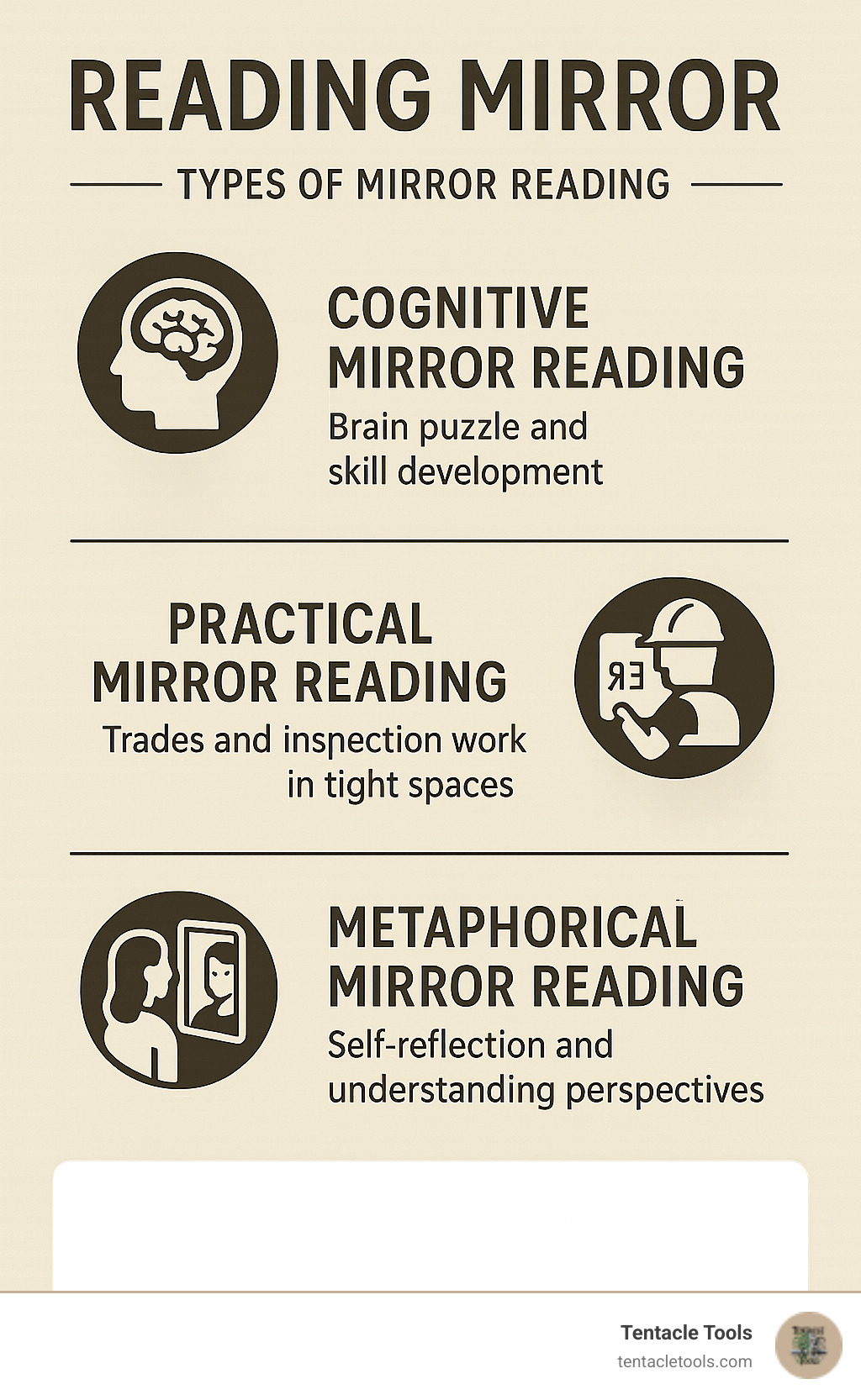
Reading mirror vocab to learn:

Ever wonder why reading mirror text makes your brain feel like it's doing gymnastics? The answer lies in some fascinating physics that most people get completely wrong.
Here's the thing that blows everyone's mind: mirrors don't actually flip things horizontally. I know, I know - it sure looks like they do. But what's really happening is way more interesting.
When light hits a mirror, it bounces back in what scientists call specular reflection. The mirror reverses everything along the z-axis - that's the invisible line running from front to back, not side to side. Think of it like this: when you hold up text to a mirror, you're seeing what that text would look like if you were somehow viewing it from behind the paper.
This parity inversion is why the word "AMBULANCE" on the front of an emergency vehicle looks perfectly normal in your rearview mirror. The mirror is doing exactly what it's supposed to do - showing you the back-to-front view.
Here's a fun fact that might surprise you: most mirrors actually have a slight green tint because they reflect green light more efficiently than other colors. According to research on mirror physics, this happens because of the silica glass used in mirror construction. So technically, mirrors aren't perfectly neutral - they're subtly green.
The secret to understanding mirror reversal is realizing it's a front-to-back flip, not a left-to-right flip. When you wave your right hand at a mirror, the reflection appears to wave its left hand because you're seeing yourself as if from the opposite side.
This z-axis reversal is what makes reading mirror text such a mental workout. Our brains spent years learning to recognize letters in one specific orientation. When that orientation gets flipped along the depth dimension, every single letter becomes a puzzle our visual system has to decode.
The parity inversion affects more than just individual letters - it scrambles the entire reading process. In normal text, we cruise from left to right. In mirror text, we need to work from right to left while simultaneously flipping each letter back to its correct form in our minds.
Our brains are pattern-recognition machines, and we've trained them from childhood to instantly recognize letters in their standard orientation. When we encounter mirror text, we're essentially asking our visual processing system to run in reverse.
The challenge goes way beyond just seeing letters differently. We're fighting against years of ingrained reading habits. Every time we look at mirror text, our brain has to juggle multiple tasks: recognizing the text is reversed, mentally flipping each letter, processing letters in backward order, and combining everything into meaningful words.
This cognitive load explains why most people read mirror text much slower than normal text and make more mistakes. We're literally battling our brain's trained responses.
Letter recognition becomes especially tricky because some letters look identical when flipped (like A, H, and O), while others become completely different shapes (like R becomes Я). This spatial change forces our visual system to work overtime, which is why even experienced tradespeople need quality tools when they're trying to read serial numbers or markings in tight spaces using a mirror.
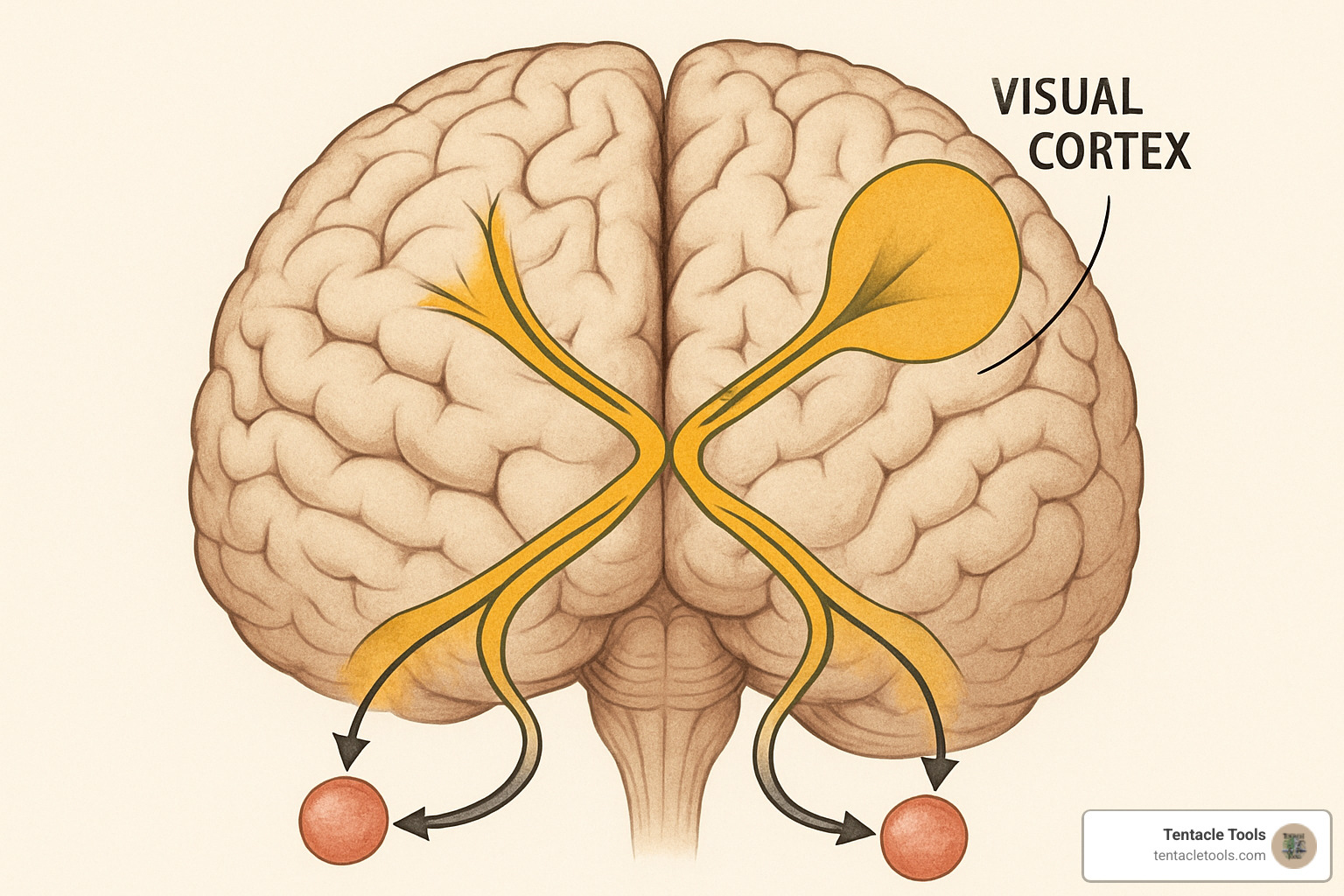
The ability to read reading mirror text isn't just a clever party trick - it opens a window into the remarkable flexibility of our brains. When neuroscientists study people reading mirror text, they find something fascinating: our brains are rewiring themselves in real time.
Unlike normal reading, which follows well-worn neural highways, mirror reading forces your brain to take the scenic route. It activates areas involved in spatial processing and visual rotation - parts of your brain that normally stay quiet when you're reading a book. It's like asking your brain to suddenly drive backwards while looking in the rearview mirror.
This process reveals what researchers call "learned paralysis." Our brains become so comfortable with processing text in one direction that they actually resist going the other way. It's similar to phantom limb syndrome, where the brain holds onto old patterns even when circumstances change dramatically.
Here's where it gets really interesting: stroke rehabilitation research shows that mirror therapy can help retrain damaged brains. When patients use mirrors to create visual feedback, they sometimes recover abilities that doctors thought were gone forever. This proves our brains are far more adaptable than we once believed - a concept scientists call neuroplasticity.
If you've ever watched someone effortlessly read mirror text while you're still struggling with the first word, you're not imagining things. Scientific studies have found clear evidence that some people have natural advantages when it comes to reading mirror text.
The biggest factor is handedness. Left-handed people consistently outperform right-handed folks in mirror reading tasks. In controlled studies, lefties make fewer errors and read mirror text much faster than their right-handed counterparts.
The advantage comes from differences in brain organization. Left-handed people seem to have more flexible neural pathways for processing reversed visual information. When researchers project mirror words to different parts of people's visual fields, both groups perform better when the text appears on the left side. But here's the kicker: left-handers also excel when mirror text appears on the right side.
This gives left-handed individuals what scientists call "hemifield superiority" - they can process mirror information effectively no matter which side of their visual field it appears in. It's like having a backup system that most right-handed people don't possess.
The research also shows that people with greater cognitive flexibility - the ability to switch between different mental tasks - tend to pick up mirror reading more quickly. This explains why some tradespeople who regularly work with mirrors and tight spaces seem to develop this skill naturally.
The great news is that reading mirror text is absolutely a learnable skill. While some people start with natural advantages, anyone can improve their mirror reading abilities through practice and training.
Your brain's neuroplasticity means it can adapt to new visual processing demands at any age. When people practice mirror reading regularly, they develop new neural pathways that make the task easier and more automatic. It's like building a new road in your brain.
Studies tracking people learning to read mirror text show encouraging patterns. Reading speed improves significantly with practice - often doubling or tripling within a few weeks. Error rates plummet as your brain gets comfortable with the reversed orientation. Most importantly, the mental effort required decreases as mirror reading becomes more automatic.
The key is consistent practice. Start with simple three-letter words and gradually work up to more complex text. Many people find that practicing for just 10-15 minutes a day leads to noticeable improvements within a few weeks. Your brain is literally rewiring itself to handle this new challenge.
For tradespeople who need to read serial numbers or markings in tight spaces, developing this skill can be a game-changer. Instead of struggling to mentally flip text while holding a magnetic inspection mirror in an awkward position, you can read the information directly and confidently.
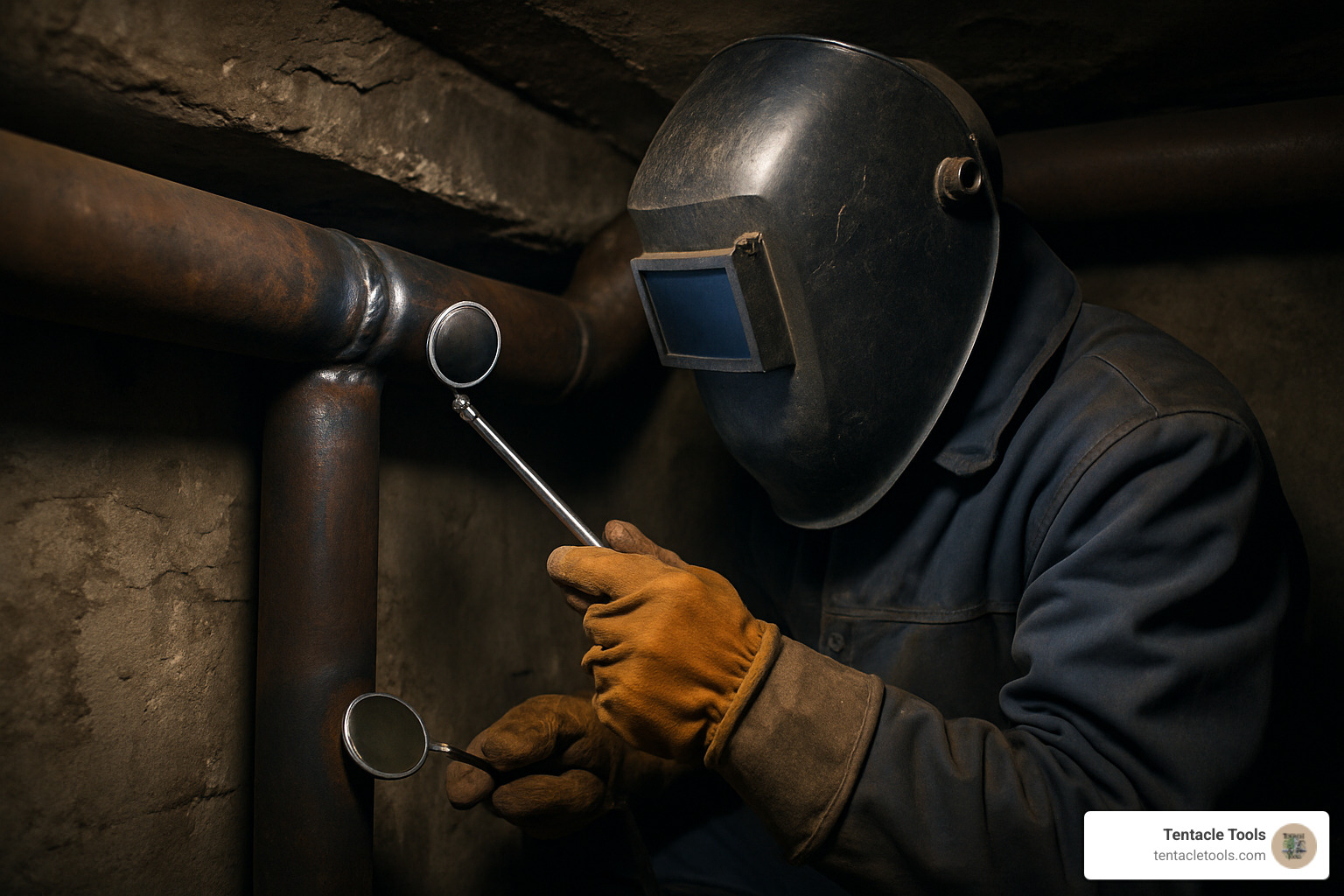
Leonardo da Vinci famously wrote his notes in mirror script, possibly to keep his ideas secret or simply because it felt more natural as a left-handed person. What started as Renaissance cryptography has become an essential skill for modern tradespeople who need to read critical information in impossible-to-reach places.
In today's industrial world, reading mirror tools aren't just convenient - they're often required for safety and quality control. I've watched skilled welders use mirrors to inspect pipe joints in spaces so tight you can barely fit your hand inside. The challenge isn't just seeing into cramped areas - it's being able to read serial numbers, pressure ratings, and inspection marks when they appear backwards in the reflection.
A misread number on a pressure valve or a missed crack in a weld can have serious consequences. That's why mastering the art of mirror reading has become a practical skill that separates experienced tradespeople from beginners.
In the skilled trades, reading mirror tools serve critical functions that go far beyond simple inspection. We rely on them daily for inspecting hidden welds - checking for cracks, porosity, or incomplete penetration in joints that are impossible to see directly.
Reading serial numbers becomes essential when you need to identify equipment and components in tight spaces where direct viewing isn't possible. Quality control inspectors use mirrors to verify that markings, stamps, and certifications are correctly applied and legible on finished work.
Safety checks are another crucial application. Being able to read warning labels, pressure ratings, and operational instructions through a mirror can be the difference between a safe installation and a catastrophic failure. In pipeline welding, for example, accurately reading a pressure rating or material specification in a mirror reflection isn't just helpful - it's often a safety requirement.
The aerospace industry has acceptd reading mirror technology for inspecting aircraft components in areas where human eyes can't reach directly. These applications demand precision and clarity that only high-quality mirrors can provide.
Not all mirrors work the same for professional use. At Tentacle Tools, we've learned that the right mirror depends on your specific needs and working conditions.
Telescoping mirrors are essential for reaching into deep, narrow spaces. Look for models with adjustable length and sturdy construction that won't bend under pressure. Lighted mirrors solve the common problem of trying to read text in poorly lit areas - LED models provide bright, even illumination without generating heat that could affect sensitive equipment.
Magnifying mirrors help when you need to read small text or identify fine details, particularly useful for inspecting serial numbers or reading gauge markings. Non-inverted mirrors are game-changers for tradespeople who regularly need to read text - these specialized tools use a dual-mirror system to show a corrected, non-reversed image, eliminating the mental work of flipping text.
Material choice matters too. Glass mirrors provide the clearest image but are more fragile in tough working conditions. Acrylic mirrors are lightweight and shatter-resistant but can scratch easily with heavy use. Stainless steel mirrors are nearly indestructible and perfect for harsh industrial environments, though they may not provide as crystal-clear a reflection as glass.
The key is matching your mirror to your specific trade and working conditions. What works perfectly for automotive mechanics might not be ideal for pipeline welders working in extreme temperatures.
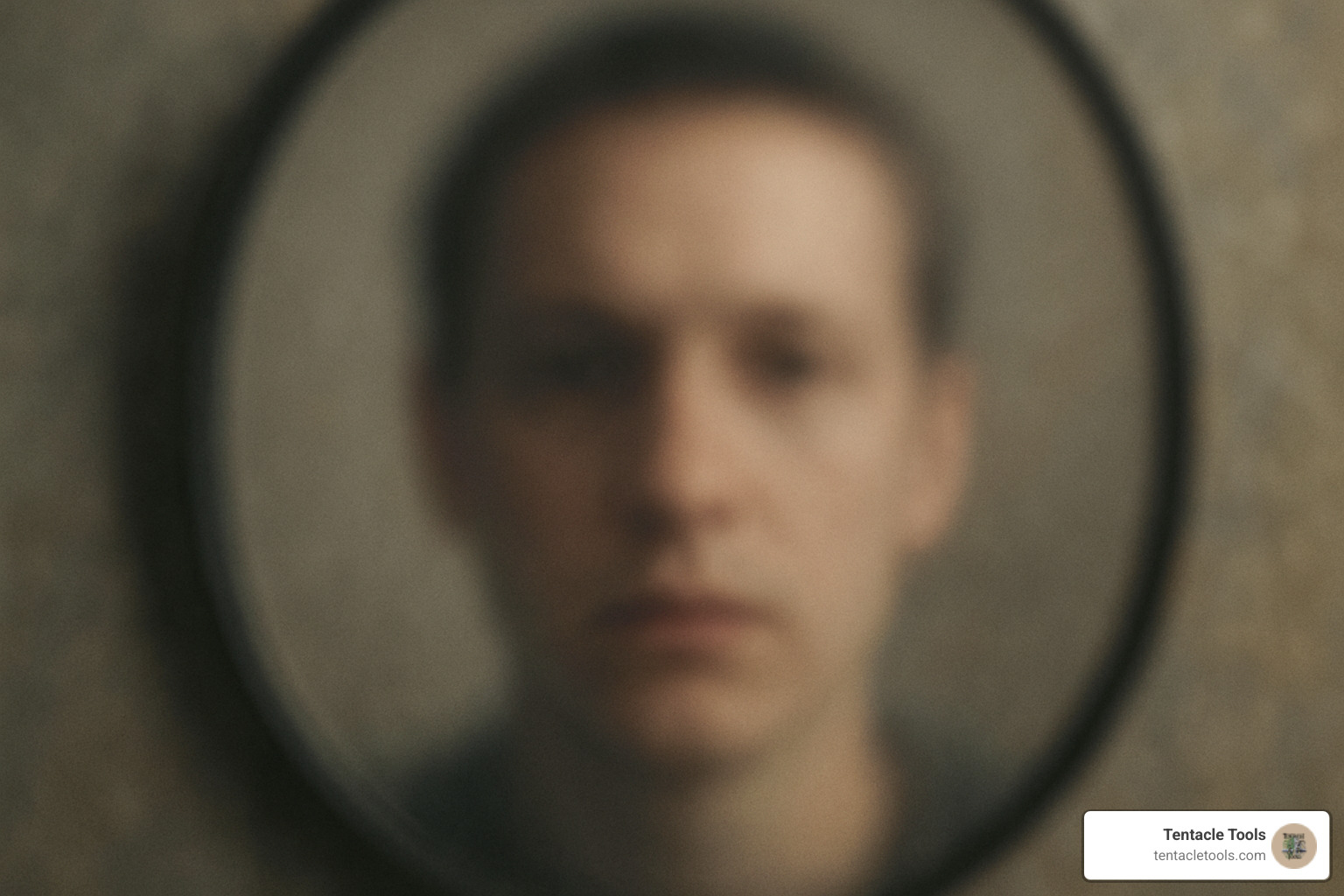
The skill of reading mirror text opens up a fascinating world that goes far beyond welding inspections and trade work. When we dig deeper into how mirrors affect our minds, we find some pretty wild stuff about human psychology and perception.
Ever stare into a mirror for too long and feel like something's... off? There's actually science behind that creepy feeling. It's called the Troxler Effect, named after physician Ignaz Paul Vital Troxler, who in 1804 finded that our eyes do strange things when we focus on one spot for too long.
What happens is this: when you stare at a fixed point in a mirror, your visual system starts to adapt. The unchanging parts of what you're seeing begin to fade away, and your brain – which hates gaps in information – starts filling in the blanks with whatever it can find. Sometimes that means projecting images from your unconscious mind right onto your reflection.
This isn't just some old-timey medical curiosity. Modern researchers are still studying how mirrors mess with our heads in ways we're only beginning to understand.
Giovanni Caputo, a cognitive psychologist, decided to put this mirror weirdness to the test. He had fifty brave volunteers sit in a dimly lit room and stare at their own reflection for ten minutes straight. What happened next sounds like something out of a horror movie.
The results were genuinely unsettling. 66% of participants saw huge deformations of their face – imagine looking in a mirror and watching your features twist and change. 18% saw animals like pigs or cats staring back at them instead of their own face. Even stranger, 28% observed completely unknown people in the mirror, and 48% saw monstrous or fantastical beings.
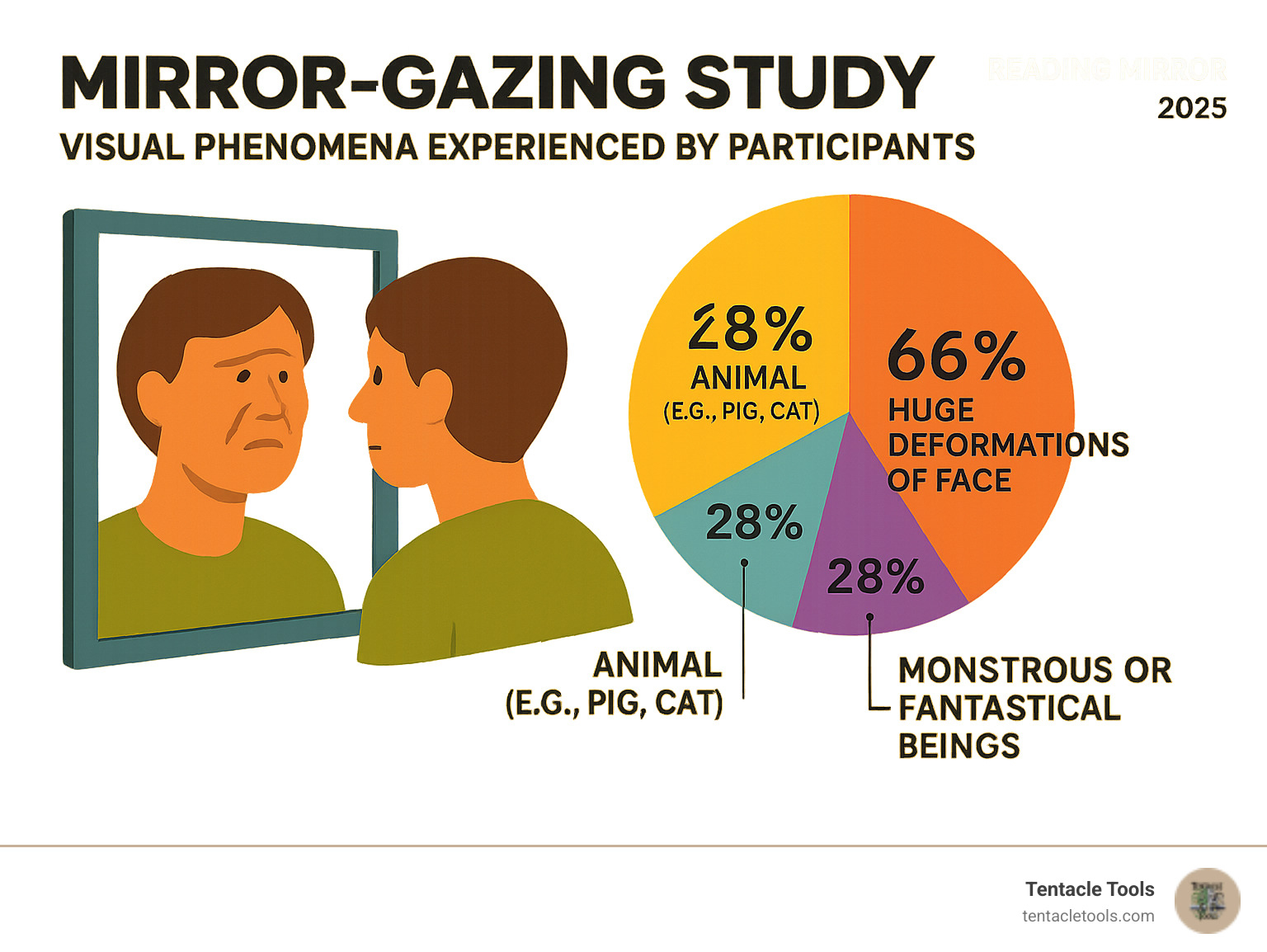
This "strange-face illusion" happens because of something called peripheral fading. When you focus on one point, your brain stops paying attention to the stuff around the edges. But here's the kicker – your brain can't handle missing information, so it starts making stuff up to fill in the gaps.
What you end up seeing isn't really there. It's your brain's attempt to make sense of incomplete visual data, and sometimes that means projecting fears, memories, or random neural activity onto your reflection. It's like your unconscious mind is suddenly running the show.
This research reveals something pretty profound about how we see reality. What we think is a simple reflection is actually our brain actively constructing an image based on light, memory, and a whole lot of neural processing we're not even aware of.
Beyond all the psychological weirdness, mirrors have always meant something deeper to humans. Educational researcher Rudine Sims Bishop came up with this brilliant idea about texts being like mirrors, windows, and sliding glass doors. Mirrors reflect our own experiences back at us, windows show us other people's perspectives, and doors let us step into completely different worlds.
This metaphorical way of thinking about reading mirror extends way beyond just decoding reversed text. When we truly "read" a mirror, we're doing a form of self-examination that can reveal things about ourselves we might not otherwise notice.
In the trades, we use mirrors to see into tight spaces and inspect our work. But in life, mirrors force us to confront our own image and, by extension, who we really are. It's why mirrors show up so often in literature, psychology, and spiritual practices throughout human history.
The ability to read mirrors – whether literally or metaphorically – is about more than just flipping letters around in your head. It's about developing the flexibility to see things from different angles, to understand perspectives that might be reversed from your own, and to find meaning even when the information comes to you backwards.
That's a skill that serves you well whether you're inspecting a weld in a cramped pipeline or trying to understand someone whose worldview is completely different from yours.
Reading mirror text feels like trying to write with your opposite hand - everything your brain knows about processing text suddenly works against you. Our minds spend years perfecting the art of left-to-right reading, building neural highways that expect letters to appear in familiar orientations.
When you look at mirror text, your brain has to slam on the brakes and reverse course. Every letter becomes a puzzle that needs solving, and every word requires mental gymnastics to decode. Scientists call this "cognitive load" - essentially, your brain is working overtime to fight against its own training.
It's like being a seasoned welder who suddenly has to work left-handed while wearing thick gloves. The skills are there, but everything feels backwards and clumsy. Your visual processing system keeps trying to read the text normally, creating a constant mental tug-of-war that slows you down and increases errors.
The research is pretty clear on this one - left-handed folks definitely have an edge when it comes to reading mirror text. Studies show they make fewer mistakes and can decode reversed text faster than right-handed people.
The advantage seems to come from how left-handed brains are wired. Growing up in a right-handed world, lefties develop more flexible neural pathways for handling spatial information. They're constantly adapting to tools, writing systems, and layouts designed for right-handed people, which builds mental muscles that come in handy for mirror reading.
Think of it like this: if you've spent your whole life figuring out workarounds and mental reversals, tackling mirror text is just another day at the office. Right-handed people, on the other hand, haven't had as much practice with this kind of spatial flexibility.
A non-inverted reading mirror is a game-changer for anyone who needs to read text in tight spaces regularly. Instead of showing you backwards text that your brain has to decode, these specialized tools use a clever dual-mirror system to flip the image back to normal.
Picture this: you're trying to read a serial number on a valve buried deep in a pipe assembly. With a regular mirror, you'd see something like "54321-ABC" when the actual number is "CBA-12345." Your brain has to work backwards to decode it, and there's always a chance you'll make a mistake.
A non-inverted mirror shows you "CBA-12345" right from the start - no mental gymnastics required. This isn't just convenient; it's a safety issue. When you're dealing with pressure ratings, material specifications, or equipment identification numbers, getting it wrong can have serious consequences.
These tools are essential for quality control inspections, safety checks, and equipment maintenance in industries where precision matters. Whether you're checking weld certifications, reading gauge markings, or verifying component numbers, a non-inverted mirror eliminates the guesswork and speeds up the job.
You know, the ability to read a mirror isn't just a clever party trick. It's truly a fascinating look into how our brains work. And it's become a super important skill in today's industrial world. Think about it: from the science of how light bounces off a mirror to how our brains can actually learn this unique skill, mirrors really challenge how we see things. They even show us hidden parts of our own minds!
For the hardworking men and women in the trades, a top-notch reading mirror isn't just a nice-to-have. It's a must-have tool. It helps them get the job done right, ensuring everything is precise and safe. Whether you're checking a critical weld in a tight pipeline, reading a serial number on a cramped engine part, or making sure gauge readings are spot-on in a factory, being able to accurately read that reflected text can save you from big, costly mistakes.
We've learned that while some folks might be naturally better at mirror reading (hey, left-handers!), anyone can get good at it with a little practice. Our brains are truly amazing and can adapt!
Here at Tentacle Tools, we're incredibly proud to stand with the hard-working tradesmen and women of America. We make tough, American-made tools so you can tackle any job, no matter how hard. Our reading mirror tools are built by tradespeople, for tradespeople. They're made to handle the toughest conditions and still give you the clear, precise view you need for safety and quality.
So, from Leonardo da Vinci's secret notes to inspecting modern pipelines, the art of reading mirrors keeps growing. It's a cool mix of old mysteries, new brain science, real-world needs, and even a bit of psychology. Every time you look into a mirror, you just might find something new about the world—and about yourself.
Explore insights, tips, and trends in tech and productivity!